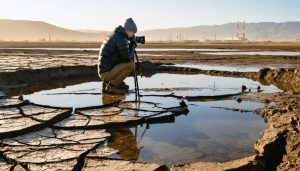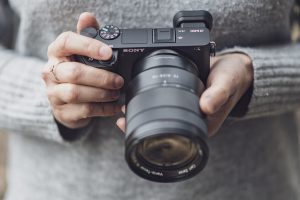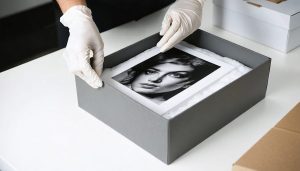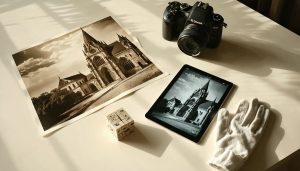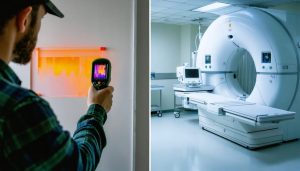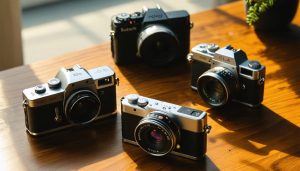
Examine forgotten photograph collections in local libraries, historical societies, and family attics—these seemingly ordinary images contain precise architectural details, measurements, and spatial relationships that modern photogrammetry software can transform into accurate 3D reconstructions of destroyed landmarks. When Notre-Dame Cathedral caught fire in 2015, art historian Andrew Tallon’s laser scans proved invaluable, but thousands of tourist photographs taken from multiple angles provided additional texture and color data that digital models needed. Your own photographs of heritage sites, even casual vacation snapshots, might one day serve this crucial preservation purpose.
Access digitized collections through platforms like the Library of Congress, Europeana, and regional archives that house millions of historical images spanning 150 years of photography. These repositories document everything from demolished buildings in war-torn cities to natural landmarks altered by climate change. Researchers actively mine these archives for overlapping images of the same structure, which algorithms can analyze to extract depth information and spatial coordinates. The Mosul reconstruction project, for example, relied heavily on crowdsourced photographs after ISIS destroyed ancient sites, demonstrating how distributed collections create redundancy that protects cultural memory.
Learn proper documenting cultural heritage techniques that maximize your images’ archival value: shoot structures from multiple angles with 30-60% overlap between frames, include scale references like people or known objects, capture detail shots of decorative elements, and maintain consistent lighting conditions. Upload georeferenced images with accurate metadata to initiatives like CyArk or local heritage organizations, ensuring future generations possess the visual data needed to reconstruct what time, conflict, or disaster might erase.
Why Historic Photo Archives Matter More Than Ever
When flames engulfed Notre-Dame Cathedral in April 2019, the world watched in horror as centuries of history seemed destined to vanish. Yet within days, historians and architects began piecing together a digital resurrection of the structure, thanks to thousands of photographs taken by tourists, scholars, and photographers over the decades. This wasn’t an isolated incident—it revealed something crucial about our modern age: photographic archives have become our civilization’s backup drive.
Historic photo archives serve as visual time capsules that document not just how places looked, but how people lived, worked, and built their communities. When the ancient city of Palmyra fell to deliberate destruction in 2015, researchers turned to photographic records dating back to the 19th century to understand what was lost and what might be rebuilt. These images, many stored in university collections and national archives, provided the measurements, textures, and contextual details that written descriptions alone could never capture.
The value extends beyond catastrophic losses. Cities undergo constant transformation through development and modernization, often erasing architectural heritage in the process. Photographs documenting urban transformation become invaluable references for understanding how communities evolved and what design elements defined different eras. A single photograph from 1920 might reveal construction techniques, material choices, or decorative elements that modern architects can reference when restoring period buildings.
Climate change adds new urgency to this mission. As coastal erosion threatens historic sites and extreme weather events become more frequent, the race to document heritage locations intensifies. Organizations like CyArk have pioneered digital documentation projects, but they rely heavily on historical photographs to provide temporal context and verify changes over time.
The Iraqi National Library and Archives lost millions of documents during the 2003 conflict, but photographs preserved in international collections helped identify what existed and guided recovery efforts. Similarly, after the 2015 Nepal earthquake, reconstruction teams consulted century-old photographs to understand original temple designs and construction methods that had been passed down through oral tradition but never formally documented.
These archives matter because memory is fragile. Digital technology makes preservation easier, but it also means today’s casual snapshot might become tomorrow’s crucial historical document. Every photograph you take of your local landmark, historic building, or neighborhood streetscape potentially contributes to this collective memory—a visual insurance policy for future generations who may need to understand, reconstruct, or simply remember what once stood.

The Science Behind Photographic Reconstruction
Photogrammetry: Turning 2D Images Into 3D Models
Photogrammetry works by identifying common points across multiple photographs taken from different positions, then using geometric principles to calculate the spatial relationships between those points. Think of it like triangulation—when you view an object from two different spots, your brain calculates depth. Photogrammetry software does the same thing, but with dozens or even hundreds of images.
The process begins when the software analyzes each photograph, identifying distinctive features like architectural details, texture patterns, or structural elements. It then matches these features across multiple images, creating a point cloud—essentially a constellation of coordinates in 3D space. From there, the software constructs a mesh that connects these points, forming a dimensional model that can be textured using the original photographs.
Historic photographs present unique opportunities and challenges for this technique. The Notre-Dame Cathedral reconstruction in Paris provides a compelling example. After the 2019 fire, researchers compiled thousands of tourist photos taken over decades. Despite varying camera qualities, lighting conditions, and angles, photogrammetry software successfully extracted spatial data to aid restoration efforts. Similarly, the Institute for Digital Archaeology used historic photographs to recreate Palmyra’s Arch of Triumph after ISIS destroyed it in 2015.
What makes a historic photograph useful for photogrammetry? The key factors include sufficient overlap with other images—ideally capturing the same features from different perspectives—and reasonable clarity. Sharp details matter more than high resolution. Multiple photos showing the same architectural element from various angles work better than a single perfect shot. Even old glass plate negatives from the early 1900s can yield remarkable dimensional data when processed correctly.
Lighting consistency across images helps, though modern software can compensate for many variations. Perhaps surprisingly, casual snapshots often prove more valuable than formal architectural photography, simply because tourists naturally photograph structures from diverse viewpoints. That vacation photo collection gathering dust in your attic might contain crucial spatial information about a building that no longer exists—or may not survive the next disaster.

The Challenge of Working With Vintage Photography
Working with vintage photographs presents fascinating challenges that go far beyond simply scanning old images. When specialists attempt to reconstruct lost heritage sites, they’re essentially archaeological detectives, piecing together visual clues from photographs that were never intended for this purpose.
The most immediate obstacle is inconsistent quality. Historical archives contain everything from pristine glass plate negatives to faded postcards and water-damaged prints. Each photograph might have been taken with different film stocks, cameras, and processing methods, resulting in varying levels of detail, contrast, and color accuracy. A site might be documented through dozens of tourist snapshots but lack the comprehensive coverage needed for accurate 3D modeling.
Limited perspectives compound this difficulty. Unlike today’s systematic documentation, historic photographs captured whatever caught a visitor’s eye. You might find twenty images of a building’s ornate entrance but nothing showing the side walls or roof details. This forces reconstruction specialists to make educated guesses or rely heavily on architectural knowledge to fill gaps.
Different film formats add another layer of complexity. Medium format, large format, and various obsolete film sizes each recorded information differently. Specialists must understand how these formats captured depth, perspective, and distortion to accurately extract usable data. Modern photo restoration techniques help enhance degraded images, but they can’t recreate information that was never captured.
Exposure inconsistencies further complicate matters. Overexposed skies, underexposed shadows, and blown-out highlights can hide crucial architectural details that reconstruction efforts desperately need.
What can today’s photographers learn from these challenges? Document comprehensively. If you’re photographing a historic site, shoot from multiple angles and heights. Capture details alongside wide shots. Include scale references like people or objects. Shoot in RAW format to preserve maximum information. Take overlapping images that could support photogrammetry. Consider that your casual vacation photos might someday be invaluable historical records. Your thorough documentation today could make the difference between an accurate reconstruction and pure guesswork tomorrow.
Inside the Archives: Where These Precious Images Live
Major Institutional Archives Leading the Way
Several major institutions around the world have become powerhouses in preserving and sharing historic photographs, making them invaluable resources for heritage reconstruction projects. Understanding how these organizations work can help you tap into centuries of visual history.
The Library of Congress in the United States houses over 15 million photographs, including the remarkable Civil War collections and early American documentation that have proven essential for reconstructing historical sites. Their Prints & Photographs Division has developed sophisticated cataloging systems that tag images by location, date, photographer, and subject matter, making it remarkably easy to find specific buildings or landmarks. They’ve digitized millions of images, many available for free download in high resolution perfect for photogrammetric analysis.
UNESCO’s Memory of the World Programme coordinates preservation efforts across 193 member states, establishing best practices for digitizing fragile photographs. Their guidelines have helped standardize how institutions handle everything from daguerreotypes to color slides, ensuring future generations can access these visual records. When the Notre-Dame Cathedral caught fire in 2019, researchers immediately turned to photographs archived through UNESCO partnerships to aid reconstruction planning.
The British Library holds approximately 4 million photographs spanning from the 1840s onward, with particularly strong collections documenting colonial architecture across Asia and Africa. Their catalog system links related images together, so searching for one building might reveal photographs taken from multiple angles and time periods, exactly what reconstruction teams need.
Museum photography departments like those at the Getty Museum and the Victoria and Albert Museum don’t just preserve images—they actively collaborate with digital reconstruction projects. These institutions employ conservation specialists who restore deteriorating photographs and metadata experts who ensure every image includes detailed provenance information, contextualizing what you’re viewing and when it was captured.

Crowdsourced Archives: When the Public Becomes the Curator
When Hurricane Maria devastated Puerto Rico in 2017, historians feared countless architectural treasures were lost forever. But an unexpected archive emerged: thousands of vacation photos uploaded by tourists to platforms like Flickr and Instagram. This scenario illustrates a revolutionary shift in heritage preservation—where everyday photographers become inadvertent archivists.
The Million Image Database, launched by Oxford’s Institute for Digital Archaeology, exemplifies this crowdsourced approach. The initiative collects tourist snapshots, family albums, and amateur photographs of at-risk sites across the Middle East and North Africa. When ISIS destroyed Palmyra’s ancient temples, researchers reconstructed accurate 3D models using hundreds of casual photos taken by visitors over decades. Each snapshot, though individually incomplete, contributed crucial perspectives that professional surveys might have missed.
Similarly, Project Mosul (now Rekrei) transforms photographic documentation by ordinary travelers into digital preservation tools. The platform accepts any image—blurry selfies, background shots, even accidental captures—of endangered cultural sites. Advanced photogrammetry software stitches these diverse images into comprehensive digital models.
This democratization of heritage preservation carries profound implications for photographers. That spontaneous shot you took at an ancient temple isn’t merely a vacation memory—it’s potential historical documentation. Consider backing up travel photos to dedicated preservation platforms or geotagging images of historic sites. Your casual photography might someday provide the only remaining evidence of cultural treasures, proving that preservation work doesn’t require professional credentials, just an observant eye and willingness to share.
Remarkable Reconstruction Success Stories
Nothing demonstrates the power of historic photo archives quite like seeing a destroyed landmark rise again from dusty photographs. These reconstruction success stories show how careful documentation by photographers—sometimes decades ago—now enables us to rebuild what we thought was lost forever.
The Notre-Dame Cathedral restoration provides perhaps the most compelling recent example. When fire ravaged the iconic Parisian landmark in 2019, architects initially worried about accurately reconstructing the intricate details. Enter Andrew Tallon, an art historian who had laser-scanned the entire cathedral between 2010 and 2015, combining his scans with thousands of historic photographs dating back to the 1850s. These images, taken from multiple angles by tourists and professional photographers alike, provided crucial verification points for the digital models. What made this reconstruction possible was the sheer volume of overlapping photographs—the same architectural details captured from dozens of perspectives across different eras, allowing teams to cross-reference measurements and confirm accuracy down to the millimeter.
Halfway around the world, the Bamiyan Buddhas project showcases digital reconstruction of Afghanistan’s sixth-century statues, destroyed by the Taliban in 2001. Researchers at ETH Zurich used approximately 1,500 historic photographs—many taken by tourists with simple cameras—to create detailed 3D models through photogrammetry. The key to success here was photographic diversity. Images ranged from professional archaeological documentation shot on large-format cameras in the 1970s to casual snapshots from the 1960s. Even seemingly insignificant tourist photos proved valuable because they captured details from angles professional photographers hadn’t considered important. The variety of focal lengths, distances, and lighting conditions actually strengthened the reconstruction by providing different perspectives on surface textures and proportions.
The Old Summer Palace in Beijing represents an ambitious ongoing project where nineteenth-century photographs are bringing imperial gardens back to life virtually. Photographers who documented the palace before its destruction in 1860 unknowingly created an invaluable archive. Modern teams analyze these albumen prints for architectural proportions, decorative details, and landscape arrangements. The challenge here involves working with limited documentation—unlike Notre-Dame’s thousands of photos, only dozens of images exist. Researchers compensate by extracting every possible detail from each photograph, using computational photography techniques to enhance faded prints and recover information from damaged areas.
The Warsaw Old Town reconstruction after World War II stands as history’s most remarkable physical reconstruction from photographs. Students at Warsaw’s Architecture Department had meticulously photographed and measured the historic district before the war. These photographs, combined with paintings by eighteenth-century artist Bernardo Bellotto, enabled architects to rebuild the district stone by stone. The success hinged on methodical documentation—systematic photographs that captured not just attractive views but boring technical details like doorway measurements, window placement, and stonework patterns.
These projects share common photographic elements that made reconstruction possible: multiple viewing angles, systematic documentation of details, varied scales from wide establishing shots to close-ups, and most importantly, preservation of original prints or negatives that retained maximum information. They prove that every photograph of a historic site potentially contributes to preservation, whether you’re shooting with professional equipment or a smartphone.
What Photographers Can Do to Help Preserve Tomorrow’s Heritage

Best Practices for Documentary Heritage Photography
When documenting heritage sites for future reconstruction, your approach matters as much as your equipment. Start by shooting structures from multiple angles—capture each building facade from at least three different positions, ideally forming a triangular pattern around the subject. This gives reconstruction software the overlapping views it needs to create accurate 3D models.
Focus on details that tell the complete story. Photograph architectural elements like doorways, windows, decorative moldings, and structural joints from close range. Include scale references by capturing people, vehicles, or common objects in some frames—these become invaluable when recreating actual dimensions. Don’t forget contextual shots showing how buildings relate to their surroundings and neighboring structures.
Lighting conditions significantly impact reconstruction quality. Shoot during overcast days when possible, as even lighting reduces harsh shadows that can confuse photogrammetry software. If you’re working with vintage photography, understanding how historical lighting conditions affected images helps maintain consistency in documentation standards.
Save files in uncompressed RAW format to preserve maximum detail and dynamic range. TIFF works as a secondary option, but avoid heavily compressed JPEGs for archival purposes. Each photograph should include embedded metadata noting the exact location (GPS coordinates), date, time, camera settings, and brief descriptions of what’s captured.
Share your work with established heritage archives like the Library of Congress, local historical societies, or specialized platforms like Arches or OpenHeritage. Many museums now accept digital submissions from citizen documentarians. Tag your uploads with specific building names, addresses, and historical periods to make them discoverable when reconstruction efforts begin. Remember, you’re not just taking pictures—you’re creating tomorrow’s historical record.
Contributing Your Images to Heritage Archives
Do you have old family photographs or heritage images gathering dust in your albums? These treasures could help preserve cultural history. Getting started is surprisingly straightforward.
First, assess your images for historical value. Photographs documenting demolished buildings, vanished neighborhoods, cultural events, or everyday life from past decades are particularly valuable. Even seemingly ordinary snapshots can provide crucial context for reconstruction projects.
Major institutions like the Library of Congress, Smithsonian Institution, and local historical societies actively accept public submissions. Many have dedicated online portals with simple upload forms. For example, the Library of Congress’s “Crowd Sourcing” project welcomes community contributions with clear submission guidelines on their website.
Digital platforms like Flickr Commons and WikiMedia Commons offer accessible alternatives, connecting your images with researchers worldwide. These platforms typically require Creative Commons licensing, allowing archivists to use your photos while you retain ownership. The Creative Commons Attribution license (CC BY) is most useful for heritage reconstruction, as it permits wide usage with proper credit.
Before submitting, create high-resolution scans at 600 DPI minimum. Include everything you know about the image: location, approximate date, subjects, and photographer if possible. This metadata significantly increases research value.
Remember, imperfect photos still matter. Even damaged or faded images can provide irreplaceable information about lost heritage sites, making your contribution genuinely meaningful.
Every photograph you capture today is a potential historical document for tomorrow. We’ve seen how images from personal albums, commercial archives, and even social media have become invaluable resources for reconstructing heritage sites lost to conflict, natural disasters, and time itself. The tourist snapshot taken at Palmyra in 2010 became crucial evidence after ISIS destroyed the ancient city. The family photo from 1950s Dresden helped researchers understand architectural details that had been forgotten for generations.
This reality transforms the way we should think about photography, particularly when documenting culturally significant sites, historic buildings, or even everyday streetscapes that future generations might need to understand. You don’t need specialized equipment or training to contribute meaningfully to tomorrow’s archives. What matters is thoughtful documentation: capturing structures from multiple angles, including contextual details, noting dates and locations accurately, and preserving your images in accessible formats.
Consider establishing your own practice of heritage documentation. When visiting historic sites, take systematic photographs beyond the typical vacation shots. Upload to reputable archives when possible. Share images with local historical societies. Store your files with metadata intact and backups secured.
The photographers who documented Notre-Dame Cathedral before the 2019 fire probably never imagined their work would become essential reconstruction references. Yet that’s precisely what happened. Your photographs carry that same potential. Each thoughtfully composed image of a historic place isn’t just a personal memory—it’s a gift to the future, a piece of insurance against the uncertainties of time. Photograph with purpose, preserve with care, and contribute to the collective memory that helps humanity rebuild what we’ve lost.


